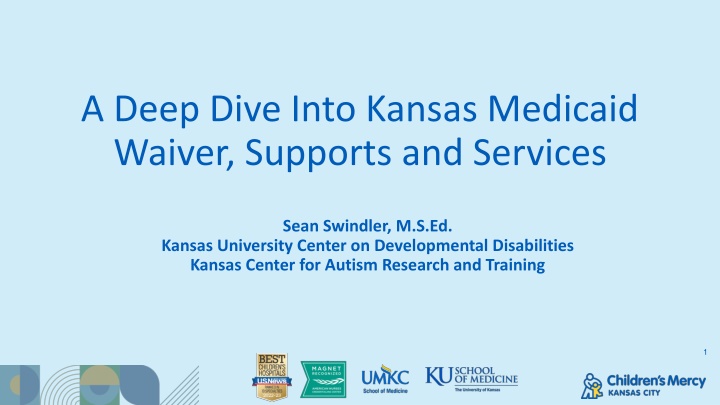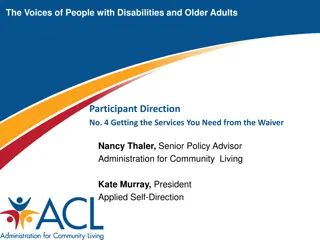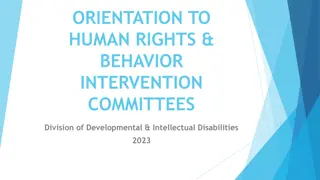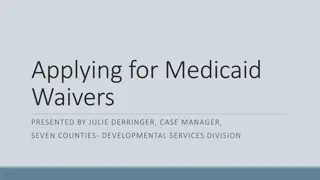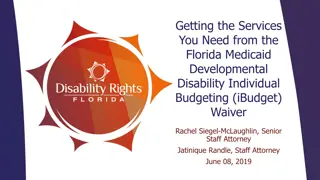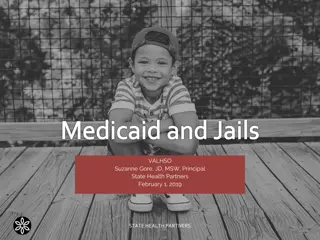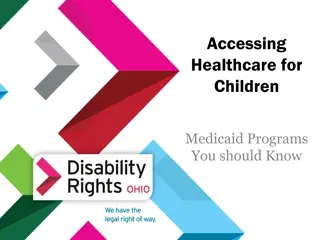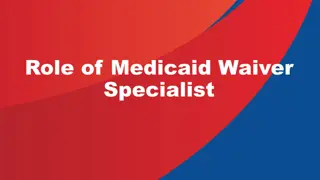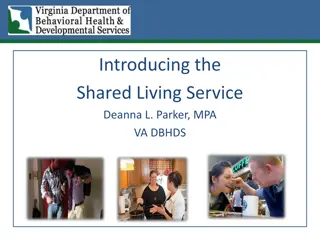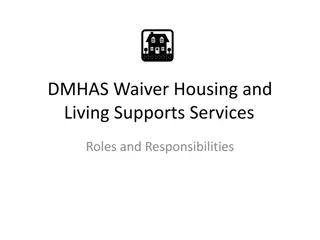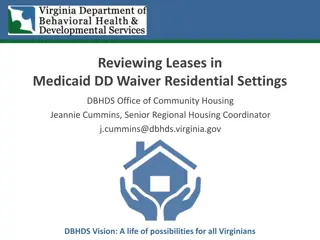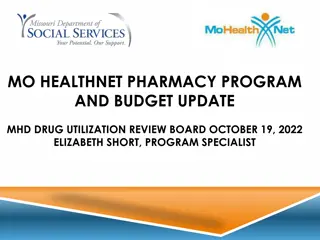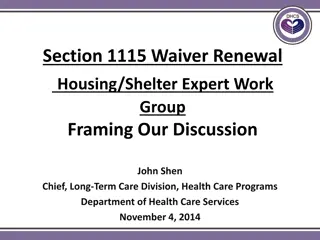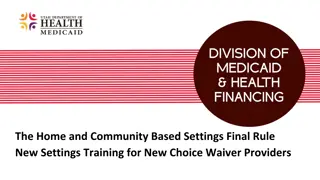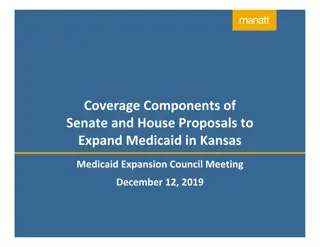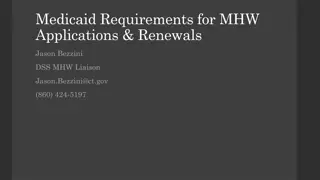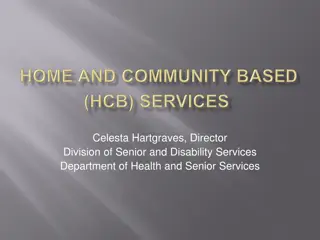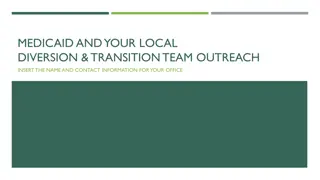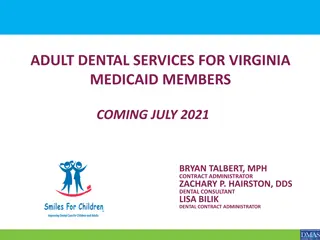A Deep Dive Into Kansas Medicaid Waiver, Supports and Services
This document explores the Kansas Medicaid waiver, special education services under IDEA, and educational transitions for students from age 3 to exiting public education. It delves into the concept of transition services, covering the importance of preparing students for adulthood through a coordinated set of activities. Additionally, it discusses the Supplemental Security Income and transition checklist for individuals turning 18.
Download Presentation

Please find below an Image/Link to download the presentation.
The content on the website is provided AS IS for your information and personal use only. It may not be sold, licensed, or shared on other websites without obtaining consent from the author.If you encounter any issues during the download, it is possible that the publisher has removed the file from their server.
You are allowed to download the files provided on this website for personal or commercial use, subject to the condition that they are used lawfully. All files are the property of their respective owners.
The content on the website is provided AS IS for your information and personal use only. It may not be sold, licensed, or shared on other websites without obtaining consent from the author.
E N D
Presentation Transcript
A Deep Dive Into Kansas Medicaid Waiver, Supports and Services Sean Swindler, M.S.Ed. Kansas University Center on Developmental Disabilities Kansas Center for Autism Research and Training 1
Special Education Purpose of the IDEA: to ensure that all children with disabilities have available to them a free appropriate public education that emphasizes special education and related services designed to meet their unique needs and prepare them for further education, employment, and independent living. 20 U.S.C. 1400(d)(1)(A) (emphasis added). 2
Educational Transitions Age 3: exit from Part C, Infant/Toddler Services Age 5: entrance into kindergarten (full-day) Grade 6: entrance into middle school Grade 9/10: entrance into high school Age 14 for Vocational Rehabilitation referral. Grade 12: graduation from high school Age 18-21: continued education at high school or specialty school By Age 22: exit from public education 3
What is Transition? Transition services are intended to prepare students to move from the world of school to the world of adulthood. 4
SpEd Transition Services Transition services are a coordinated set of activities To facilitate the child s movement from school to post-school activities, including post- secondary education, vocational education, integrated employment (including supported employment), continuing and adult education, adult services, independent living, or community participation; Are based on the individual child s needs, taking into account the child s strengths, preferences, and interests; and Include instruction, related services, community experiences, the development of employment and other post-school adult living objectives, and, when appropriate, acquisition of daily living skills and functional vocational evaluation. 20 USC 1401(34) 5
Transition Checklist WHEN: 6 months prior to turning 18 1. Supplemental Security Income (SSI) Monthly payment for people who meet eligibility most people who have I/DD qualify, some people with Autism qualify Most people who receive SSI are also Medicaid eligible Prior to 18, children who qualify do not receive SSI unless FAMILY income meets guidelines When your child turns 18, if they are SSI eligible, THEIR income (which is likely ZERO) is what counts for income eligibility 6
Transition Checklist 3. Vocational Rehabilitation and PRE-ETTS (Pre-Employment Transition Services) Most people who are eligible for SSI are also eligible for VR. VR Can provide Pre-employment services (more on this!) Job development Job coaching Pay for vocational training Pay for degree seeking college programs Assist with transportation and other things needed to achieve employment goals 7
Vocational Rehab VR program provides services and supports to help people with disabilities: prepare for, secure, retain, advance in, or regain employment Rehabilitation Act, 2006, 722 (a)(1) 8
Transition Checklist 3. PRE-ETTS (Pre-Employment Transition Services) Eligibility: The student is 16-21 years of age. The student is in a secondary, post-secondary or other recognized education program. The student is eligible for, and receiving services under an Individual Education Plan or 504 Plan, or the student is an individual with a disability, as defined by Section 504 of the Rehabilitation Act. The student is a resident of Kansas. Services are designed to provide an early start at job exploration and to assist students with disabilities in making the transition from secondary to post-secondary education/training and competitive, integrated employment 9
Transition Checklist 3. PRE-ETTS (Pre-Employment Transition Services) 10
Transition Checklist New: STEPS program STEPS is a program through KDHE and is facilitated by a Community Services Coordinator who helps participants prepare for employment, increase independence, receive and maintain health care coverage, and provide on-going supports to help maintain employment. https://kancare.ks.gov/consumers/working-healthy/steps 12
Transition Checklist New: STEPS program The eligibility requirements for STEPS are as follows: Must be a KanCare beneficiary aged 16 to 65, and Must qualify under one of the following criteria: Individuals who receive SSI or SSDI and have one or more qualifying behavioral health diagnoses; Individuals who receive SSI and are waitlisted for the Physical Disability (PD) or Intellectual or Developmental Disability (I/DD) home and community-based services waiver; or Individuals who are current on the Brain Injury (BI), Physical Disability (PD), or Intellectual or Developmental Disability (I/DD) home and community-based services waiver who wish to leave their waiver to participate in STEPS. 13
Transition Checklist WHEN: Age 5 (if possible) or anytime after 2. Kansas Intellectual and Developmental Disabilities Waiver Disability manifests before age 22 and substantial limitation in 3 or more areas of life functioning Community Developmental Disability Organizations (CDDO) are single point of entry Can apply for services starting at age 5 BUT it is not unusual to discover during High School years that a person may be eligible 10 Year Waiting List for services 14
HCBS Waiver A Home and Community Based Services (HCBS) waiver is an authorization from Medicaid that allows a beneficiary to receive treatment at home or in a community setting, rather than being required to enter an institution. The HCBS waiver program was initiated in the 1980s. Individual states administer their own waiver programs and have specific information on how to apply for their programs. Social workers and counselors can assist people with the process. Historically, Medicaid only provided funding to institutions like nursing homes. People eligible for Medicaid who needed skilled nursing services, personal care, and related services were forced to enter institutions in order to access benefits. 15
Medicaid Above: President Lyndon Johnson signing Medicaid into law-1965, seated on the right is former President Harry Truman Passed in 1965, provides federal funds matched by states to provide medical assistance to residents who cannot afford it 16
EPSDT Early and Periodic Screening, Diagnostic and Treatment Original part of Medicaid in 1967 Preventative treatment and comprehensive care Provides comprehensive treatment for all medically-necessary 17
CHIP Children s Health Insurance Program (CHIP) signed into law at the federal level in 1997. Adopted in Kansas in 1998, implemented in 1999. Covers children in families with incomes too high for Medicaid but who can t afford private coverage. Authorized by Congress through 2023. Total cost of $17.5 billion nationally in 2017. 18
What is MANAGED CARE? Managed care is a delivery system intended to manage cost, utilization and quality. Medicaid and CHIP services can be provided through contracts between state agencies and managed care organizations (MCOs). MCOs are paid per member/per month capitation payments that place them at risk for the cost of care. MCOs contract with providers to deliver care. 19
HCBS Waiver Requirements State HCBS Waiver programs must: Demonstrate that providing waiver services won t cost more than providing these services in an institution Ensure the protection of people s health and welfare Provide adequate and reasonable provider standards to meet the needs of the target population Ensure that services follow an individualized and person-centered service plan 22
Kansas HCBS Waivers Waivers are an agreement with CMS of what services and how we provide services to different populations. These waiver applications cover everything from assessment, level of care (who, what, where and how) To services, what services, duration amount and scope. To ensuring health and welfare, program evaluation, appeal rights etc., 23
Kansas Waivers http://www.kdads.ks.gov/commissions/home-community-based-services-(hcbs) Autism (AU) - child who starts services before age 6 Frail Elderly (FE) - 65+ years Intellectual and Developmental Disability (I/DD) - 5+ years Physical Disability (PD) - 16-64 years Serious Emotional Disturbance (SED) - 4-18 years Technology Assisted (TA) - 0-21 years Traumatic Brain Injury (TBI) 5-64 years 24
Medicaid Waivers Medicaid Waiver programs help provide services to people who would otherwise be in an institution, nursing home, or hospital to receive long-term care in the community. Prior to 1991, the Federal Medicaid program paid for services only if a person lived in an institution. The 1915(c) waiveris known as the home and community-based services waiver (HCBS) because it allows states to treat certain Medicaid populations in home or other community based settings rather than in institutional or long-term care facilities such as hospitals or nursing homes. 25
Kansas HCBS I/DD Waiver eligibility (1) Intellectual Disability // substantial limitations in present functioning that is manifested during the period from birth to age 18 years and is characterized by significantly sub average intellectual functioning existing concurrently with deficits in adaptive behavior including related limitations in two or more of the following applicable adaptive skill areas: Communication, self-care, home living, social skills, community use, self-direction, health and safety, functional academics, leisure and work); Or (2) a severe, chronic disability, which: (A) Is attributable to a mental or physical impairment, or multiple sensory impairments, a combination of mental and physical impairments, physical and sensory impairments, mental and sensory impairments or a condition which has received a dual diagnosis of mental retardation and mental illness; (B) is manifest before 22 years of age; (C) is likely to continue indefinitely; (D) results, in the case of a person five years of age or older, in a substantial limitation in three or more of the following areas of major life functioning: Self-care, receptive and expressive language development and use, learning and adapting, mobility, self-direction, capacity for independent living and economic self-sufficiency; (E) reflects a need for a combination and sequence of special interdisciplinary or generic care, treatment, specialized communications techniques or other services which are lifelong, or extended in duration and are individually planned and coordinated; and (F) does not include individuals who are solely and severely emotionally disturbed or seriously or persistently mentally ill or have disabilities solely as a result of the infirmities of aging. 26
IDD: working with the Targeted Case Manager, MCO Care Coordinator, CDDO and CPA Targeted case management services are those which assist the beneficiary in gaining access to medical, social, educational, and other needed services. The DD Case Manager provides: Assessments to determine service needs (but not the functional assessment related to eligibility); Development of a specific support/care plan; Referral and related activities; Monitoring and follow-up activities. 27
CDDO Role Offers local choice of services (regulatory role) Quality assures service provision by local pro-viders Tracks waiver and waitlist children and adults Ensures that services are provided according to person-centered support plan Ensures health, safety, welfare of people within catchment area. 28
Targeted Case Management Families choose the agency or individual providing TCM TCMs work with person to do person-centered support plan Work with family to choose providers and monitor service provision Interface with MCO Care Coordinator 30
When to Notify Your MCO Care Coordinator Changes in the health of the person Changes in the behaviors of the person Changes in the health of the parent/guardian Educational transitions Need for a Waiver transition Changes in Medicaid status Involvement with Child/Adult Protective Services Involvement with Law Enforcement Involvement with the legal system 31
Changes in Medicaid Status Changes in household income Family members wages, child support, etc. Person s wages from employment Entering/exiting foster care Turning 18 years old Receiving an inheritance Receiving SSI Receiving Survivor s Benefits 32
DD Service Options Use of the Service Access (Waiting) List Use of Crisis Funding Use of Voluntary Placements for children and youth under 22 years Use of other service systems: social services; medical care; beneficiary programs 33
IDD Waitlist and Foster Care Waitlist is currently over 8 years long Person is not re-assessed once on the waitlist until the person is offered funding by KDADS Can be by-passed by foster children for non-supervisory, disability-related support needs, or Can be by-passed in crisis situations in order to avoid a child coming into custody (requires DCF/court documentation) Can be by-passed in order for a child exiting custody to have identified disability support needs met. Foster Care Exception requests go to the CDDO first, then to KDADS IDD Program Manager for review and determination. 34
IDD Crisis-Exception Requests Requests are first made through the CDDO area in which the person lives (placement area) Crisis requests based on APS/CPS, Law Enforcement, documented Abuse, Neglect, Exploitation (ANE), and/or Significant, imminent risk to self, others Community supports must first be exhausted before making a request (documentation required) Cannot duplicate services already available, or services that should be provided by the foster parent. CDDO approved requests then go to KDADS IDD Program Manager for review and determination 35
Self-Directed supports vs. agency-directed supports (in-home) Children in custody must have agency-directed in-home supports. In areas where no agency-directed supports are available for foster children, an exception for self-directed supports must go to KDADS IDD Program Manager for review and determination. Children in Children s Residential setting cannot also access in-home supports, as that constitutes a duplication of services 36
DD Waiver and Foster Care IDD Waiver supports cannot be supervisory in nature for children in custody Licensed Foster Care placements cannot have more than two children in the home unrelated to the IDD waiver participant in order for the child s waiver to continue. Any overpopulation request must happen prior to the home becoming overpopulated All overpopulation requests related to a child s waiver go to KDADS IDD Program Manager for review and determination. Overpopulation requests start between CPA and DCF Licensing. Once DCF Licensing reviews, then goes to MCO. MCO makes request to IDD Program Manager. 37
Private Pay contracts for IDD adult services 18+ person in FC: private pay contract between CPA and IDD provider Provider dependent on payment via private pay contract Prior to ROC, exception access request needs to be initiated. TCM, MCO, DCF, CPA, CDDO, and KDADS all need to be involved. Pre-planning for ROC needs to happen, and all parties need to be on the same page. 38
Childrens Residential: Licensed Foster Care setting for voluntarily placement Can only have two children in the home not related to the IDD waiver participant. Starts at age 5, ends at the latest, by the 22nd birthday Must be located in or near the child s home community (home county) Any exception requests must go to KDADS IDD Program Manager for review and determination. Cannot be used as a way to ROC a foster child. 39
Guardianship Alternatives to Guardianship: Limited guardianships Power of Attorney Conservatorship Supported Decision Making* Building in family and community/natural supports * Kansas legislation pending 40
